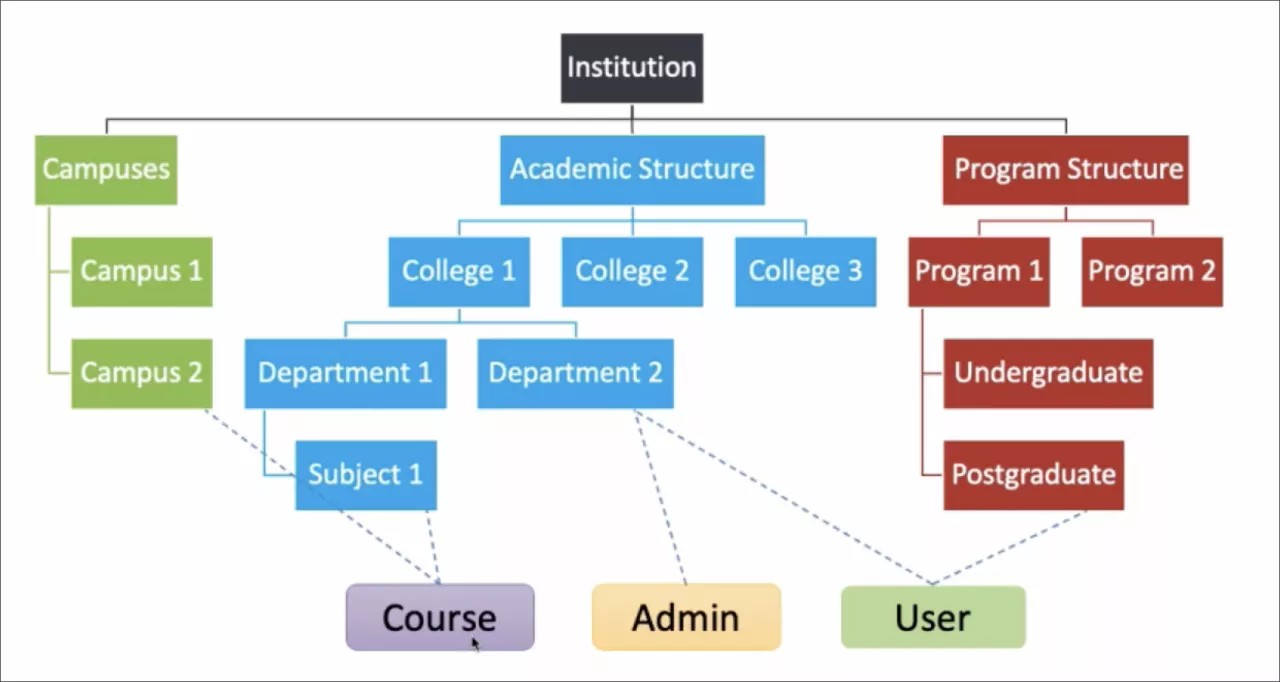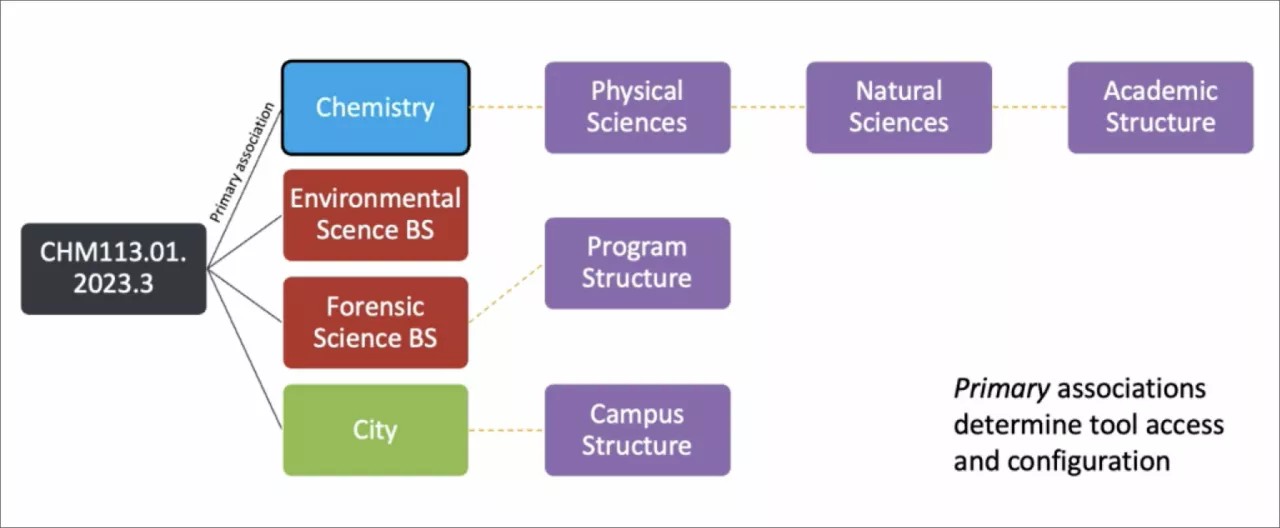This page gives an overview of Institutional Hierarchy (IH) and its uses. For information on creating and managing nodes to build out your hierarchy, go to Create and Manage Nodes. Information on this page includes:
- About Institutional Hierarchy
- Uses of Institutional Hierarchy
About Institutional Hierarchy
Blackboard Learn’s Institutional Hierarchy is a hierarchy management user interface. IH allows you to create a multi-level framework within Blackboard Learn that mirrors your organization. Effective use of IH helps with organization, distributed administration, reporting, and data segmentation.
Institutional Hierarchy is a flexible model comprised of nodes. The nodes can represent different business units of your organization. Examples of hierarchical structures include:
- separate faculties or colleges within a university;
- departments or programs with their own budgets, policies, and reporting;
- or courses that are administered by a user with privileges.
The node structure is composed of parent-child relationships. You can associate various objects to your hierarchy. You can define a Blackboard Learn course as being associated to several different nodes at once. Similarly, you can associate people to several different nodes.
Modeling Institutional Hierarchy to mirror your institutional structure helps you the delivery of your different programs in various ways like staffing, budgeting, and reporting.
For example, three potential ways to organize the hierarchy are:
- Academic structure. Probably the most common organizational structure, which mirrors an institution’s separate colleges or faculties. The colleges have departments as their node descendants. The departments, in turn, have their subjects, then courses, as their descendants. Users can be given privileges to administer segmented parts of the organization.
- Program structure. Nodes can represent an organization’s program structure. For example, a university medical program offers courses across different academic departments but can be clustered under a program node. Similarly, an academic department can have nodes represent undergraduate and postgraduate programs.
- Campus structure. Nodes can be created for separate campuses of an organization to differentiate course offerings on each campus.
All three of the described structures can be used together, and more can be added as your organization evolves.
Primary Associations
A node can have multiple associations, mirroring your institution. A node’s primary association is used to designate rules around tool access and configuration for that node.
For example, a node can represent a specific section of a chemistry course, which is associated with a specific academic term (for example, the Fall 2026 term). The node has a unique course ID to represent the specific course section. The course node may be associated to multiple places at once for different purposes:
- Subject area. The example course is taught within the Chemistry department. Since chemistry is a physical science, the node can also be associated with an institution’s Physical Science course offerings. Since physical science is one of the natural sciences, the node can also be associated with an institution’s Natural Science course offerings. The Chemistry course section now has three node associations by subject area to mirror a common university academic structure.
- Program structure. This course might be a part of different academic programs, such as an undergraduate Environmental Science program as well as an undergraduate Forensic Science program.
- Campus structure. This course offering can be associated with an institution’s downtown campus to indicate where the specific course offering meets.
When you have multiple associations to a node, there is one that's designated as primary. This primary association is used for determining specific rules around tool access and configuration. For example, an English department may not be using Blackboard Learn’s Roster tool, so the appropriate system administrator can turn it off. But in that college’s History department uses the Roster tool, so tool access would be configured differently. In another case, a Physics department may license a particular tool that it pays for. This integration is made through the primary association of the Physics department’s node.
Select a primary node association
From a new or existing object:
- Create or edit an object, such as a course or user.
- Select Find Node.
- Search for a node and select it.
- Select Submit.
If more than one node is associated, select the node you want to be primary.
It is recommended that primary associations are made where policies, budgets, and tool purchases are determined. This is generally where decisions are made about tool use and access.
Uses of Institutional Hierarchy
Institutional Hierarchy has many uses, including:
- Distributing management tasks in your organization
- Tool management
You don’t need to use all of these. Use only what gives value to your institution.
Distributing management tasks in your organization
Institutional Hierarchy allows you to distribute management tasks across your organization so that the appropriate user has the appropriate privileges to do their work. Node administrators are limited to objects they can manage in Blackboard Learn:
- Users
- Courses
- Organizations
- Tabs and Modules (legacy objects; support ends on July 31, 2024)
Once you create associations, you can then pair the node administrators to that node with a specific set of privileges based on either a default or a custom system role. The node administrator then has some degree of managerial privilege over users or courses/organizations within that node.
Example use cases include:
- A help desk that should only be able to edit user accounts associated with specific departments.
- An instructional designer needing access to any course in a program. The privileges are limited to materials and settings, and the user can’t access student data or grades.
- A QA reviewer needing access to courses without rights to make changes.
Tool management
Institutional Hierarchy allows you to manage how Blackboard Learn tools are used throughout your organization. You can set different policies for Learn tools by department or program and restrict LTI or Building Block tools from inappropriate departments or programs. We will highlight a few examples.
Multiple deployment of LTI tools. For LTI 1.3 tool providers, you have the ability to support multiple deployments of the same LTI tool in Learn. This allows you to offer wider controls on third party app licensing and course delivery. You can also support a consortia or multi-site organization with an LTI tool deployment.
Reporting. Institutional Hierarchy lets Anthology understand your organization better and optimize reporting by segmenting and rolling up data accordingly. Some Anthology products that can be integrated with IH include:
- Ally. Ally recognizes your hierarchical structure and allows you to do drill downs and segmentation into your data for reports on accessibility within your organization.
- Anthology Illuminate (formerly Blackboard Data). Anthology Illuminate looks across a broad range of data in your environment, making sense of it in multiple ways.
Institutional Hierarchy is also available for your internal developers to write their own queries or to connect to your organization’s own reporting tools. For even built-in reports, you can do segmentation and comparison to customize your reports.
Role-based access to reporting. IH allows you the ability to compartmentalize reporting. Role-based access allows a specific role to see only the aggregated data for courses or users within their defined role. For example, a department head can see course data for courses within that specific department. Or a Dean of a School of Engineering can see student data for students within that particular school. With a Blackboard Learn license, you get a set number of accounts that can receive role-based access. If you need more accounts with role-based access, you can purchase more.

